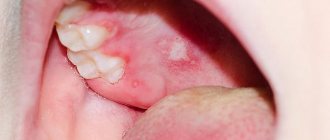More than 70% of Russians are infected with the herpes virus, but in most cases it does not pose any threat to health. The virus is relatively safe and becomes active only against a background of weakened immunity, especially in the autumn-winter period. It manifests itself in the form of a rash on the lips, genitals and other areas. As a rule, neoplasms go away on their own, but in some cases you may need to get help from a doctor.
How can you get infected with herpes
The content of the article
The disease is caused by the herpes simplex virus (HSV, Herpes simplex virus). Of the eight types of this pathogen, genital lesions are the result of two infectious agents. HSV-2 causes 80% of cases of the disease, and HSV-1 - 20%. There are also combined infections, in which both viral types are to blame.
There is a misconception that herpes on the lips and genitals are completely different diseases. In fact, both types of pathogens often “swap places” during domestic infection and oral sex. And both infections are equally dangerous.
Both types of virus are transmitted:
- For all types of sexual contact - vaginal, oral, anal, during which the virus enters the body through microdamage to the mucous membrane. You can also become infected from a partner who does not have rashes on the genitals or other manifestations of the disease. This condition is possible with strong immunity, when the virus lies low and waits in the wings. A person becomes a carrier of a herpes infection, but does not experience any health problems.
- Through common objects - washcloths, sponges, bed linen, towels. A person with a cold sore caused by the type 1 virus can become a source of genital herpes infection.
- During autoinoculation (self-infection), when the patient transfers the pathogen from the face to the genitals.
- A child becomes infected from a sick mother when the virus penetrates from the vagina into the uterus or transplacentally through the placenta. During childbirth, infection occurs as the newborn passes through the birth canal.
Statistics of hidden and overt forms of herpes
The body cannot overcome the pathogen on its own. The virus settles in the roots of the spinal cord, and the infected person continues to live with the disease throughout his life.
The pathogen can remain in the body for many years without causing symptoms. Therefore, it is impossible to know without testing for herpes whether a person is infected with the virus. According to WHO, type 1 herpes, which causes a rash on the lips and genitals, affects 67% of the world's inhabitants, and type 2 affects 11% of people. Only 20% of the disease occurs in the classical form, which is beyond doubt. In the rest, the course of the disease is latent or asymptomatic.
Prevention of herpes
The basic rules that will help reduce the likelihood of infection with viruses of the herpes family are:
- hand washing;
- limiting contact with sick people;
- nasal instillation with saline solutions during the off-season.
There is now a vaccine against chickenpox. Vaccination helps prevent infection and/or development of severe forms of the disease. “SM-Doctor” is a multidisciplinary medical institution that provides effective treatment to children facing various diseases. Herpetic infection in any of its manifestations is not a problem. The main thing is to schedule a consultation with our specialists on time. Contact us!
Primary herpes
There are three periods of illness:
- Prodromal
(precursor period), during which the temperature rises, the inguinal lymph nodes become inflamed, weakness, fatigue, and headache appear. A person experiences a condition similar to the symptoms of flu and colds. If you take an antiviral drug during this period, the disease may not develop. If the symptoms are ignored and treatment is not started on time, the second period of the disease begins. - A rash
that occurs three to four days after the onset of a flu-like condition. Common symptoms include pain, heat, swelling, itching in the genital area, anus, buttocks, pubis and perineum. Soon, numerous blisters filled with clear liquid appear on the inflamed skin and mucous membranes, reminiscent of a “cold” on the lips. The rash causes pain and itching, worse at night and leading to insomnia. - Ulcerations.
After some time, the blisters burst and ulcers (erosions) form in their place, surrounded by a focus of inflammation. Contact with stool and urine on the eroded surface increases pain and complicates tissue regeneration. - Healing,
during which the ulcers gradually heal. If the genital organs are poorly cleaned, the immune system is weak, and infection occurs, the healing process is delayed.
After the ulcers disappear, the disease goes into remission. During this period, despite the presence of the virus in the body, there are no rashes on the genitals.
Recurrent herpes
In 50%-70% of people the disease becomes chronic. This is facilitated by:
- untimely or incorrect treatment;
- decreased immunity, including that caused by taking medications that suppress the immune system;
- presence of other STDs;
- strict diets, vitamin deficiencies;
- state of chronic stress.
Why do patients develop relapses, during which the disease affects the same parts of the body? There are several reasons for this:
- Having penetrated the body, the virus settles in the tissues of the genital organs. As it multiplies, it affects cells deeper and deeper until it reaches nerve cells - neurons connected to each other by processes - axons. Through them, like bridges, the pathogen reaches the cells of the spinal cord, into which it introduces its DNA.
- An infected brain cell becomes an “incubator” for viruses, which periodically return via axon bridges to the mucous membrane or skin, causing new rashes. Schematically, the process is similar to the migration of birds, constantly returning to their “native places.”
- The immune system cannot kill viruses hidden in the spinal cord, but it deals with those that have left the “shelter”. Therefore, with high immunity, relapses occur rarely or not at all. But as soon as the body “loses its vigilance” - weakens, gets sick, catches a cold, is exposed to stress - the pathogens begin to overcome the immune defense. As a result, they reach their target - the skin and mucous membranes of the genital organs. Here, the increased reproduction of viral particles inside the “captured” cells begins. Cellular structures, dying, release myriads of viruses that cause inflammation, redness, swelling and the appearance of blisters. Herpes is causing another aggravation.
- Gradually, the immune system fights back the virus, and within 10 days the ulcers at the site of the rash dry out and heal. Everything returns to normal, so that at the slightest weakening of the immune system it can start again.
From the mechanism of exacerbations, it becomes clear why herpetic eruptions appear in the same places. It’s just that the virus cells return back only through the nerve cell from which they penetrated deep into the body.
Types of recurrent herpes
Depending on the number of exacerbations, several types of the disease are distinguished:
- mild, occurring up to 3 times a year;
- moderate severity, in which exacerbations occur 4-6 times a year;
- severe, accompanied by frequent exacerbations, intervals between which do not exceed a month;
- arrhythmic, in which after a period of imaginary well-being, lasting from a month to five, rashes appear. This form of herpes is characterized by a pattern - the longer the remission, the more severe the disease;
- menstrual, manifested by rashes during menstrual periods. This type of disease is severe and difficult to treat;
- subsiding, in which the manifestations of the disease constantly become weaker, and the inter-relapse periods become longer. The subsidence of the manifestations of the disease indicates the positive dynamics of treatment and the restoration of immune defense that suppresses the virus.
Chronic recurrent hepatic stomatitis in children
Chronic recurrent hepatic stomatitis in children is characterized by complaints of burning and pain in the oral cavity when eating and talking. Sometimes parents pay attention to how the child treats food intake (refuses to eat completely or eats very little). A decrease in the child’s activity also becomes noticeable, tearfulness and irritability appear.
Upon examination, single rashes of aphthous elements or a group of closely spaced small blisters are revealed on the red border of the lips, the skin of the lips, on the wings of the nose, the anterior part of the palate, the tip of the tongue, the genitals and the mucous membrane of the eyes. The lips and oral mucosa are favorite sites for herpes, especially in areas that are normally keratinized.
On the first day of the disease, areas of hyperemia or diffuse hyperemia appear on the oral mucosa, against which white, finely focused spots form. Spider veins are observed on the periphery of these spots. Against the background of the hyperemic mucous membrane of the oral cavity, whitish areas are clearly contoured and turn into necrotic foci, tightly fused to the underlying tissues. A rim of hyperemia surrounds the necrotic area and is a demarcation line.
In the next 2-3 days, the rim of the hyperemia becomes pale and erosion forms due to maceration of the damaged area. On the upper and lower lips there are vesicles, single or in groups, containing a clear liquid. Over time, their contents darken. The bubbles can merge into large blisters up to 1.5 cm in diameter, which burst easily and the contents shrink into yellow-gray crusts. Often the bubbles burst with the formation of bright red erosions with jagged edges. The mucous membrane of the oral cavity is swollen, hyperemic, blisters on the mucous membrane open in the first hours after their appearance, erosions in their place have an irregular scalloped shape and are covered with a fibrinous film. In severe cases of the disease, malaise, muscle pain, chills, and a temperature of 38-39C appear.
The number of relapses per year depends on the resistance of the child’s body.
Atypical forms of herpes
Sometimes genital herpes is erased. These forms of the disease account for 65% of cases of the disease:
- In women,
atypical herpes resembles inflammation of the vagina or vulva. There is pain, itching and swelling of the genital organs, profuse leucorrhoea and pain during sexual intercourse. External manifestations are limited to areas of redness or pinpoint rashes. - In men,
the atypical form of the disease is similar to inflammation of the head and foreskin (balanitis or balanoposthitis). A reddish rash appears on the mucous membrane of the penis, accompanied by pain and burning, which does not look like a herpetic rash. Inflammation of the prostate gland occurs, causing pain radiating to the anal area. Damage to the urethra leads to pain and burning when urinating, and the appearance of traces of blood in the urine.
There is a latent form of the disease in which there are no clinical manifestations, but despite this, the person remains a source of infection. But imaginary well-being does not last forever. With hypothermia, loss of strength, decreased immune defense, pregnancy, stress, severe concomitant diseases and other unpleasant conditions, the virus begins to multiply rapidly and the person becomes ill.
The disease is activated by concomitant sexually transmitted infections, especially ureaplasmosis. Due to the ability to rapidly “bloom” against a background of weakened immunity, herpes occurs in 90% of HIV patients. Therefore, if herpetic rashes appear, you need to be examined for other STDs.
Development of infection
A decrease in the child’s immunity for various reasons contributes to the occurrence of herpes, for example, caused by factors such as emotional and physiological stress, exacerbation of chronic and the appearance of acute diseases. In addition, children under 3 years of age have a physiologically weakened immune system, and therefore are especially susceptible to contracting a herpes infection. The first appearance of symptoms of a herpes infection is possible against the background of a developing or passing cold. And if herpes has settled in the body, then its activity can manifest itself in the presence of other diseases, for example, acute respiratory viral infections, which significantly suppress the immune response.
Features of the course of genital herpes during pregnancy
The number of positive (seropositive) reactions to herpes viruses 1 and 2 in pregnant women is 50-70%. Due to the increased load on the body and decreased immune defense, herpes often relapses during this period. But only 30% of women experience the classic development of the disease. Basically, the symptoms of herpes during pregnancy are limited to the appearance of areas of redness and cracks, which women mistake for irritation.
The manifestation of a herpetic infection caused by recurrence is not dangerous for the child. The woman’s body has already built up immunity to infection by producing antibodies—substances that protect her from the virus. Some of the antibodies will pass from mother to baby, protecting him from infection.
Only a relapse that occurs immediately before childbirth is dangerous. To prevent infection of the baby and rupture of inflamed tissues, women with a herpetic rash on the genitals are advised to deliver by cesarean section.
It is much worse when the infection is primary. Herpes belongs to a group of infections, infection of which for the first time during pregnancy leads to the birth of children suffering from developmental delays and congenital defects.
Herpes tests for pregnant women: interpretation and prognosis of pathologies in the fetus
To determine the degree of risk for the baby, a woman’s blood is taken for IgM and IgG antibodies, the concentration of which determines when infection occurred. The analysis is carried out using the ELISA method (immunofluorescence), which reacts to IgM and IgG antibodies to the virus. By the presence or absence of antibodies, you can find out whether a woman is infected and when the infection occurred:
- IgM antibodies
appear after 2-3 weeks. after the onset of the disease, therefore indicating a “fresh” infection or relapse of infection. These antibodies disappear after 1-2 months. after recovery. The presence of IgM in the analysis is a bad sign. - IgG class antibodies
- appear as protection against the virus after 2 weeks. field of infection, quickly increase the titer (concentration) and persist throughout life. Their detection means that the body encountered a herpes infection and managed to cope with it.
It is bad if a fourfold increase in IgG is combined with the detection of IgM. This means that antibodies are being formed right now, i.e. the woman is sick.
Infection with the herpes virus is determined in the laboratory. It is better to undergo such an examination twice - before pregnancy and during it.
Table of interpretation of results for herpes
| IgM | IgG | What does it mean | What to do | |
| – | – | The woman is healthy (seronegative) - she has never had herpes | Before pregnancy | During pregnancy |
| In order not to become infected, you need to avoid contact with people who have manifestations of herpes, incl. on the lips. Periodic antibody monitoring is recommended | ||||
| – | + | Female carrier (seropositive) | The infection occurred a long time ago and does not pose a danger to the child, no measures are needed | |
| + | – | Recent infection | It is better to plan pregnancy after acute symptoms subside and re-examination | Consult a doctor and undergo additional diagnostics to find out if everything is okay with the baby. |
| + | + | Exacerbation of infection | It is better to plan pregnancy after acute symptoms subside | Recurrent herpes is less dangerous than primary herpes, so the likelihood of complications and intrauterine infection is only 0.02% |
Fetal pathologies in children infected with herpes during pregnancy
The most dangerous thing for a child is primary infection of the mother during pregnancy, which leads to many complications.
| Gestational age at primary infection | Possible complications |
| I trimester (up to 13 weeks) | Fading pregnancy, miscarriages, severe malformations |
| II trimester (14-27 weeks) | Child infection, internal organ defects, fetal death |
| III trimester (29-40 weeks) | Intrauterine infection, death of a child after birth, premature birth, hearing, vision, and nervous system defects of the child. Subsequently - mental retardation. |
How does the virus enter a child's body?
Penetration of the herpes virus into a child’s body usually occurs in the first few years of life. The predominant route of penetration of the herpes simplex virus is airborne (with sneezing, coughing, tiny droplets of saliva when talking) and contact (by touching). In the case of untreated herpes in the mother during pregnancy and childbirth, intrauterine infection of the fetus is possible. Herpes in children in this situation is a dangerous condition, which can be accompanied by numerous lesions of internal organs and tissues. In most children exposed to herpes viruses during the postpartum period, the infectious agent does not manifest itself in any way, being in a “dormant” state in the cells of the nervous system. Replication (reproduction) of the virus is blocked by the work of the passive and active mechanisms of the child’s immunity. But this is apparent prosperity.
Herpes in newborns
A child becomes infected with the pathogen from the mother in utero or by passing through an infected genital tract during childbirth. In newborns, the mucous membranes of the eyes and mouth, skin, and genitals are affected. When the pathogen enters the child’s brain, meningoencephalitis occurs, causing death or severe disability.
A generalized form is possible, in which all organs and systems of the newborn are affected. The child experiences jaundice, respiratory distress, and urinary retention. Children are restless, do not latch on to the breast, and are vomiting. Death occurs from shock, bleeding, dehydration, intoxication, and organ failure.
The likelihood of infection increases with primary infection of the mother in late pregnancy.
Epstein-Barr virus infection
An infectious disease caused by the Epstein-Barr virus (EBV) and characterized by a systemic lymphoproliferative process with a benign or malignant course.
EBV is isolated from the body of a patient or virus carrier with oropharyngeal secretions. Transmission of the infection occurs through airborne droplets through saliva, often when a mother kisses her child, which is why EBV infection is sometimes called the “kissing disease.” Children often become infected with EBV through toys contaminated with the saliva of a sick child or a virus carrier, when using shared utensils and linen. Blood transfusion and sexual transmission of the infection are possible. Cases of vertical transmission of EBV from mother to fetus have been described, suggesting that the virus may be the cause of intrauterine developmental anomalies. Contagiousness during EBV infection is moderate, which is probably due to the low concentration of the virus in saliva. The activation of infection is influenced by factors that reduce general and local immunity. The causative agent of EBV infection has a tropism for the lymphoid-reticular system. The virus penetrates the B-lymphoid tissues of the oropharynx and then spreads throughout the body's lymphatic system. Infection of circulating B lymphocytes occurs. The DNA virus penetrates into the nuclei of cells, while the proteins of the virus give infected B-lymphocytes the ability to continuously multiply, causing the so-called “immortality” of B-lymphocytes. This process is a characteristic feature of all forms of EBV infection.
EBV can cause: infectious mononucleosis, Burkitt's lymphoma, nasopharyngeal carcinoma, chronic active EBV infection, leiomyosarcoma, lymphoid interstitial pneumonia, hairy leukoplakia, non-Hodgkin's lymphoma, congenital EBV infection.
Diagnosis of herpes
If genital herpes is suspected, after an external examination, scrapings from the affected areas, blood, and urine are taken for examination. This will allow you to differentiate the disease from other skin lesions that have similar symptoms.
For diagnostics the following is used:
- Cultural method - during the study, the contents of the vesicles are transferred to a growing chicken embryo; if it dies, the disease is confirmed. The method is reliable, but too time-consuming.
- PCR is a test that detects viral DNA in tissues. The method allows you to calculate the pathogen even from a small amount of viral material. Effective for diagnosing any form of disease, incl. hidden. The method can be used immediately after infection before symptoms of the disease appear. PCR not only detects the virus, but also determines its type.
- Methods aimed at determining antigens and antibodies to the pathogen: ELISA - immunofluorescence diagnostics, CFR (complement fixation reaction), various types of agglutination reactions. With their help, you can identify the type of pathogen, determine its quantity and duration of infection.
A complete diagnosis of herpes virus infection allows you to make the correct diagnosis in order to prescribe treatment.
Etiology
Herpes viruses contain double-stranded DNA and have a glyco-lipoprotein envelope. The sizes of viral particles are from 120 to 220 nm.
Today, 8 types of herpes viruses that have been identified in humans have been described:
- two types of herpes simplex virus (HSV-1, HSV-2),
- varicella zoster virus (VZV or HHV-3),
- Epstein-Barr virus (EBV or HHV-4),
- cytomegalovirus (CMV or HHV-5), HHV-6, HHV-7, HHV-8.
Based on the biological properties of viruses, 3 subfamilies of herpes viruses have been formed: (alpha herpes viruses, beta herpes viruses and gamma herpes viruses). A-herpesviruses include HSV-1, HSV-2, VZV.
Betaherpesviruses include CMV, HHV-6, HHV-7. They, as a rule, multiply slowly in cells, cause an increase in the affected cells (cytomegaly), are capable of persistence, mainly in the salivary glands and kidneys, and can cause congenital infections. Gammaherpesviruses include EBV and HHV-8.
Complications of herpes
The worst thing is that a herpes infection brings not only unpleasant symptoms. This virus causes many terrible complications. The most obvious ones are:
- Irritation and dryness of the skin and mucous membranes of the genital organs;
- Cracks in the genitals caused by metabolic disorders in tissues caused by herpes;
- Adhesive and cicatricial deformities of the labia, vaginal opening, perineum, urethra and rectum. The complication arises due to the specific feature of herpetic rashes appearing on the same areas of the skin and mucous membranes
- Cervical erosion leading to cancer of the reproductive organs.
- Lacerations during childbirth caused by poor distensibility of inflamed perineal tissue.
- Infection of ulcers due to microbes entering tissues not protected by the mucous membrane;
- cicatricial deformities of the penis, provoked by constant inflammatory rashes and ulcerations.
- Chronic herpetic lesions of the genitourinary area, spreading to the urethra, bladder and kidneys.
- Herpetic proctitis is inflammation of the rectum.
- Erectile dysfunction and male and female infertility.
- Neurological symptoms caused by a viral infection of the nervous system. Patients complain of pain in the sacrum, lower back, and groin. With recurrent lesions on the inner surface of the thighs, hypersensitivity of the skin occurs, manifested by a burning sensation, crawling “goosebumps”, tingling.
In severe cases, with a pronounced weakening of the immune system, viremia occurs - viral infection of the blood leading to damage to the brain, liver, lungs, adrenal glands, and intestines. This condition, even with adequate treatment, is often fatal.
About the disease
Herpetic infection is a collective concept that is used to refer to diseases that are provoked by different types of the virus of the same name.
Traditionally, in pediatric practice, pathology caused by type 1 is encountered. This is the so-called labial herpes (rash on the lips). Its peculiarity is its chronic course. It is impossible to completely get rid of the pathogen. With adequate treatment of a child with symptoms of labial herpes, stable remission can be achieved. However, at this time the virus “hides” in the nerve ganglia (ganglia), where it can remain inactive for as long as desired. When favorable conditions arise (primarily decreased appetite), it is activated again. Another common form of herpes infection that can occur in children is varicella (chickenpox). The disease is provoked by the herpes virus type 3. It is important to remember that after successful recovery, the pathogen also goes into a latent form and persists in the nerve ganglia. The risk for the patient may be a reoccurrence of the infection. The type 3 virus, when reactivated, can cause herpes zoster, which is characterized by a more pronounced clinical picture with a deterioration in the child’s well-being and the appearance of rashes along the intercostal nerves.
The specialists of the SM-Doctor clinic have extensive experience in early diagnosis and treatment of all pathologies caused by herpes viruses. Doctors provide the necessary monitoring and quality treatment for children with any form of herpetic infection.
Treatment of genital herpes
It is difficult to cure such a dangerous disease. Treatment of genital and labial herpes is long and complex. Therapy includes:
- Prescription of antiviral agents that slow down the reproduction (replication) of viruses. To maintain the effectiveness of treatment during long-term therapy, it is necessary to constantly change the prescribed medications.
- The use of drugs based on interferons - proteins released in response to viral invasion. Scientists have found that a lack of this substance provokes exacerbations of the disease.
- The use of local antiviral ointments, gels and sprays that kill viruses that have penetrated the skin and mucous membranes.
- Prescribing symptomatic medications that combat the general symptoms of the disease - reducing pain, swelling, inflammation, lowering temperature, normalizing sleep.
- Local procedures - baths and irrigations that relieve pain and prevent the penetration of secondary infections.
- Taking immunoglobulins, immunomodulators and stimulators of cellular immunity, which improve the functioning of the immune system, activate the production of antiviral antibodies and prevent relapses.
Patients suffering from genital herpes are advised to avoid wearing synthetic underwear.
Prevention of infection consists of a thoughtful choice of sexual partners, compliance with hygiene rules, periodic examination by a gynecologist and the use of emergency measures at the first symptoms of the disease.
Where to get tested and cure herpes in St. Petersburg, prices
Doctors at the modern Diana Clinic treat herpes infections in St. Petersburg. Here you can take express tests for all infections - smears, blood, etc. Tests are performed using the best methods - PCR, ELISA, etc. The cost of visiting a doctor based on test results is 500 rubles. The price of tests depends on the type of examination. For example, the cost of taking blood from a vein is only 170 rubles.
If you find an error, please select a piece of text and press Ctrl+Enter
Therapy for herpes infection
Herpes in children requires the most careful treatment. It includes:
– prescription of antiviral drugs that inhibit the reproduction of the virion, destroy and remove the virus from the body (for example, acyclovir, Zovirax),
– correction of the immunological status (alpha-2b interferon preparations), responsible for containing viral aggression towards the child’s body,
– symptomatic therapy (anti-inflammatory, disinfectants, painkillers, detoxification agents), the need for which is higher, the younger the child’s age, the prevalence of herpetic rashes and the worse the general health.









